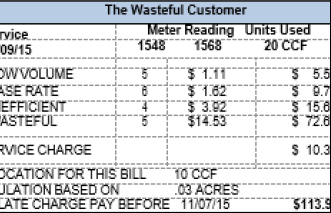Financial and Billing Information
Establishing BBRs requires communication of how/why water rates are set to provide safe and reliable water service to customers, as well as how conservation can reduce a customer’s water costs. Of concern to agencies considering switching to BBRs is the cost of BBR development and implementation, how costs are portioned out, and billing approaches, including the billing system itself and the design of the water bill.
As discussed in Billing Design, customer billing, whether the billing system used by the agency or what the water bill sent to a customer looks like, are important decisions for an agency to consider when implementing BBRs. The water bill a customer receives is crucial in helping to further customer understanding and acceptance of a BBR structure.
Regardless of the type of rate structure, whether BBRs or any other, the cost to switch rate structures, that is to develop and implement a new rate structure, is oftentimes among the largest hurdles an agency must pass before changing water rate structures. Cost of Budget-Based Rates Development and Implementation discusses the cost of switching to BBRs with numbers from agencies who have previously gone through the process of implementing BBRs.
Importance of Rate Structure Design
Submitted by IEUA
The American Water Works Association’s (AWWA) 2015 State of the Water Industry Report stated that 72% of survey respondents felt the public does not understand water systems and services.7 Water rates are one of those areas of poor understanding, if not the main area, where the public does not know what agencies really do and agencies thus have difficulty clearly communicating with customers.
The public perceives that agencies want to sell water. Yet, the real job of an agency, based on the actual costs of service, is to provide reliable and safe water when customers want it. A majority of an agency’s costs are fixed and these fixed costs are what provide “reliability” by maintaining the infrastructure, day- to-day operations, water quality requirements, the time and staff to provide safe and reliable water, etc. Water agencies have tended to tell a different story, particularly on the water bill, by describing water as expensive. If the majority of water agency costs are fixed, then that is what the bill needs to show to not only meet agency budgets, but to educate customers on the real work and costs of public agencies. Instead, much of the fixed costs are imbedded in the variable side of the bill (i.e., the water rate). A traditional rate design may be a root cause of the “disconnect” the AWWA cites between the customer and the agency in the one message every customer sees— the water bill. If the bill suggests that fixed costs (reliability costs) are low and that water is expensive, this creates the distinct potential for sending a confusing message to customers. The reality for the vast majority of agencies is the opposite. Fixed costs are high and water is still relatively inexpensive. If water bills more accurately reflected actual agency costs, then messages to customers would be more consistent with the real business of an agency. Information to the customer then reflects both what they see on a bill and what the agency actually does.
Then, the difficulty in communicating with customers may be partly due to the story agencies tell. An example is asking people to save water. When customers conserve water, agencies often raise water rates. People then get upset that agencies are simply interested in maintaining their budgets and believe that agencies really just want to sell water. Which is it—save or sell? This communication challenge really starts with the rate design and what the bill communicates to customers. The story that is generally told to customers is not the real story of what agencies do and what those costs are. When agencies are doing outreach to customers on proposed rate structures and the story of agency costs is described, customers do “get it.” This is supported by the successful Proposition 218 votes by agencies who take BBRs to customers and describe what the real agency costs are, where they show up on a bill, and that water used efficiently is inexpensive and wasted water is expensive. Examples of successful outreach with BBRs is further elaborated on in Customer Outreach, Support, and Service
The discussion at the agency should focus first and foremost on accurate and stable cost recovery, and second on water budgets or customer allocations. By ensuring the first and most important objective of revenue stability, the agency can move to the second important objective of better promoting water use efficiency.

